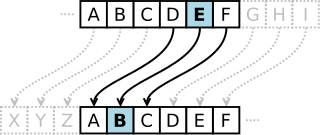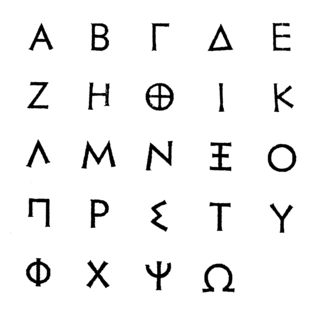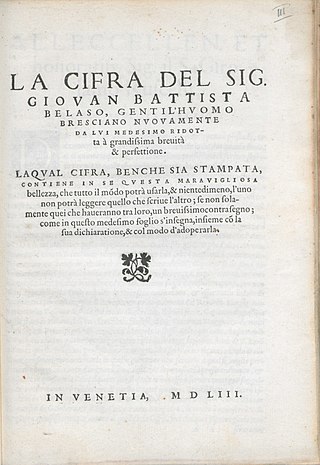
In cryptography, a cipher is an algorithm for performing encryption or decryption—a series of well-defined steps that can be followed as a procedure. An alternative, less common term is encipherment. To encipher or encode is to convert information into cipher or code. In common parlance, "cipher" is synonymous with "code", as they are both a set of steps that encrypt a message; however, the concepts are distinct in cryptography, especially classical cryptography.

Cryptanalysis refers to the process of analyzing information systems in order to understand hidden aspects of the systems. Cryptanalysis is used to breach cryptographic security systems and gain access to the contents of encrypted messages, even if the cryptographic key is unknown.

In cryptography, the one-time pad (OTP) is an encryption technique that cannot be cracked, but requires the use of a single-use pre-shared key that is larger than or equal to the size of the message being sent. In this technique, a plaintext is paired with a random secret key. Then, each bit or character of the plaintext is encrypted by combining it with the corresponding bit or character from the pad using modular addition.
In cryptography, a substitution cipher is a method of encrypting in which units of plaintext are replaced with the ciphertext, in a defined manner, with the help of a key; the "units" may be single letters, pairs of letters, triplets of letters, mixtures of the above, and so forth. The receiver deciphers the text by performing the inverse substitution process to extract the original message.

In cryptography, a transposition cipher is a method of encryption which scrambles the positions of characters (transposition) without changing the characters themselves. Transposition ciphers reorder units of plaintext according to a regular system to produce a ciphertext which is a permutation of the plaintext. They differ from substitution ciphers, which do not change the position of units of plaintext but instead change the units themselves. Despite the difference between transposition and substitution operations, they are often combined, as in historical ciphers like the ADFGVX cipher or complex high-quality encryption methods like the modern Advanced Encryption Standard (AES).

In cryptography, a Caesar cipher, also known as Caesar's cipher, the shift cipher, Caesar's code, or Caesar shift, is one of the simplest and most widely known encryption techniques. It is a type of substitution cipher in which each letter in the plaintext is replaced by a letter some fixed number of positions down the alphabet. For example, with a left shift of 3, D would be replaced by A, E would become B, and so on. The method is named after Julius Caesar, who used it in his private correspondence.

The Vigenère cipher is a method of encrypting alphabetic text where each letter of the plaintext is encoded with a different Caesar cipher, whose increment is determined by the corresponding letter of another text, the key.
In cryptography, unicity distance is the length of an original ciphertext needed to break the cipher by reducing the number of possible spurious keys to zero in a brute force attack. That is, after trying every possible key, there should be just one decipherment that makes sense, i.e. expected amount of ciphertext needed to determine the key completely, assuming the underlying message has redundancy.

The Playfair cipher or Playfair square or Wheatstone–Playfair cipher is a manual symmetric encryption technique and was the first literal digram substitution cipher. The scheme was invented in 1854 by Charles Wheatstone, but bears the name of Lord Playfair for promoting its use.

In cryptography, ciphertext or cyphertext is the result of encryption performed on plaintext using an algorithm, called a cipher. Ciphertext is also known as encrypted or encoded information because it contains a form of the original plaintext that is unreadable by a human or computer without the proper cipher to decrypt it. This process prevents the loss of sensitive information via hacking. Decryption, the inverse of encryption, is the process of turning ciphertext into readable plaintext. Ciphertext is not to be confused with codetext because the latter is a result of a code, not a cipher.

The Lorenz SZ40, SZ42a and SZ42b were German rotor stream cipher machines used by the German Army during World War II. They were developed by C. Lorenz AG in Berlin. The model name SZ was derived from Schlüssel-Zusatz, meaning cipher attachment. The instruments implemented a Vernam stream cipher.

The VIC cipher was a pencil and paper cipher used by the Soviet spy Reino Häyhänen, codenamed "VICTOR".
A straddling checkerboard is a device for converting an alphanumeric plaintext into digits whilst simultaneously achieving fractionation and data compression relative to other schemes using digits. It also is known as a monôme-binôme cipher.
In cryptography, the ADFGVX cipher was a manually applied field cipher used by the Imperial German Army during World War I. It was used to transmit messages secretly using wireless telegraphy. ADFGVX was in fact an extension of an earlier cipher called ADFGX which was first used on 1 March 1918 on the German Western Front. ADFGVX was applied from 1 June 1918 on both the Western Front and Eastern Front.

The Polybius square, also known as the Polybius checkerboard, is a device invented by the ancient Greeks Cleoxenus and Democleitus, and made famous by the historian and scholar Polybius. The device is used for fractionating plaintext characters so that they can be represented by a smaller set of symbols, which is useful for telegraphy, steganography, and cryptography. The device was originally used for fire signalling, allowing for the coded transmission of any message, not just a finite number of predetermined options as was the convention before.

In cryptography, the M-209, designated CSP-1500 by the United States Navy is a portable, mechanical cipher machine used by the US military primarily in World War II, though it remained in active use through the Korean War. The M-209 was designed by Swedish cryptographer Boris Hagelin in response to a request for such a portable cipher machine, and was an improvement of an earlier machine, the C-36.
The Two-square cipher, also called double Playfair, is a manual symmetric encryption technique. It was developed to ease the cumbersome nature of the large encryption/decryption matrix used in the four-square cipher while still being slightly stronger than the single-square Playfair cipher.

The Alberti Cipher, created in 1467 by Italian architect Leon Battista Alberti, was one of the first polyalphabetic ciphers. In the opening pages of his treatise De componendis cifris he explained how his conversation with the papal secretary Leonardo Dati about a recently developed movable type printing press led to the development of his cipher wheel.

Giovan Battista Bellaso was an Italian cryptologist.
The cipher system that the Uesugi are said to have used is a simple substitution usually known as a Polybius square or "checkerboard." The i-ro-ha alphabet contains forty-eight letters, so a seven-by-seven square is used, with one of the cells left blank. The rows and columns are labeled with a number or a letter. In the table below, the numbers start in the top left, as does the i-ro-ha alphabet. In practice these could start in any corner.













